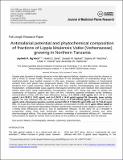| dc.description.abstract | Despite past decades of steady advances in the fight against Malaria, statistics show that the disease is still a threat to human health. Previous successes in the development of antimalarial drugs from medicinal plants have fuelled research in this area. However, antimalarial studies on fractionated extracts from such plants have progressed slowly. This study reports the antimalarial potential of fractions from Lippia kituiensis Vatke, for the first time. Column chromatography was used during fractionation. Antiplasmodial assay against chloroquine-sensitive (D6) and resistant (W2) plasmodium strains were done using hypoxanthine incorporation assay. MTT assay was used to assess the cytotoxicity of fractions against the Vero cell line. Fractions obtained exhibited varied inhibitory concentrations (IC50); with the most efficacious being, Lk-5 (19.45 ± 6.20 μg/ml), Lk-3 (30.43 ± 0.68 μg/ml), Lk-4 (30.82 ± 18.01 μg/ml), and Lk-6 (36.53 ± 14.42 μg/ml) against D6. Generally, lower activity against W2 was obtained with the most active being LK-4 (24.18±2.50 μg/ml), and Lk-5 (24.42±5.95 μg/ml), while chloroquine (positive control) exerted IC50 of 77.86±4.09 ng/ml (W2) and 15.71±6.49 ng/ml (D6). LK-4 was the most cytotoxic showing cytotoxic concentration (CC50), 46.26 μg/ml. When tested in mice, fractions suppressed Plasmodium berghei significantly compared to the negative control with Lk-3 being most efficacious (80.01±1). Due to substantive efficacy, GC-MS done on Lk-3 revealed 8 compounds where three have previously been ascribed to antimalarial activity and other pharmacological effects. This study adds to present knowledge of antimalarial efficacy of L. kituiensis and provides the basis for further work to be done on the isolation of compounds from its extracts. | en_US |

